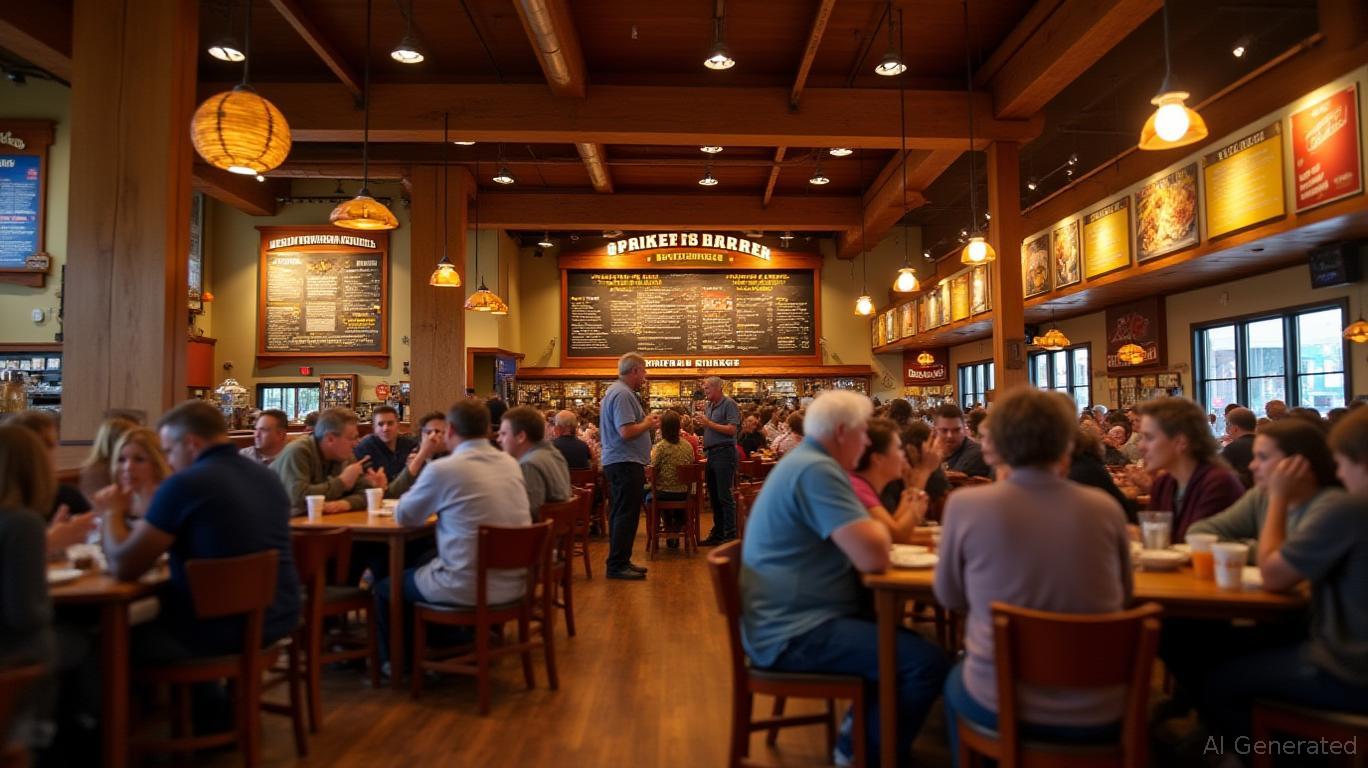AInvest Newsletter
Daily stocks & crypto headlines, free to your inbox
Cracker Barrel Old Country Store (NASDAQ: CBRL) is emerging as a compelling turnaround play in an era of dining sector turbulence, leveraging artificial intelligence (AI) integration, physical infrastructure modernization, and strategic execution to counter headwinds like tariffs. With Jim Cramer's bullish endorsement and a 2026 EBITDA target of $225 million, the company's transformation could redefine its valuation—and its stock—over the next 18 months.

Cracker Barrel's 2025 strategy is a three-pronged assault on stagnation:
1. Menu Innovation & Pricing Power: A “barbell” pricing model balances affordable staples (e.g., $7.99 Sunrise Pancake) with premium items like a $32 New York strip steak, boosting margins by 600 basis points in dinner sales.
2. Store Remodels: 50–60 locations annually are undergoing a three-tiered revamp—brighter lighting, open layouts, and modern aesthetics—to attract younger diners. Early pilots in Indianapolis show traffic and sales growth, with customer satisfaction surging.
3. Operational Efficiency: Streamlined kitchen workflows, aided by industrial engineering partnerships, are cutting labor costs and waste. By 2026, these efforts could save over $100 million annually, a critical buffer against tariff-driven inflation.
While often overlooked in Cramer's analysis, AI is quietly powering Cracker Barrel's modernization:
- Loyalty Program Personalization: The Cracker Barrel Rewards Program now uses AI to target 8 million members with tailored offers, boosting revenue per member by mid-single digits. Exclusive access to new items like the s'mores brownie skillet drives repeat visits.
- Operational Smarts: Machine learning models predict traffic patterns and labor needs, reducing staffing costs by 13% in pilot locations. These tools also optimize inventory and reduce food waste—a $100 million opportunity.
Cramer's bullish stance, despite Q3 2025 revenue misses, hinges on three pillars:
1. Leadership Execution: CEO Julie Masino's track record in turning around brands like Subway (via her prior role at Au Bon Pain) gives investors confidence in her ability to scale remodeled stores and operational improvements.
2. Margin Resilience: The restaurant segment's four consecutive quarters of comp sales growth (up 1.0% in Q3) contrasts with retail's struggles. This separation suggests the core business is stabilizing.
3. Valuation Discount: Trading at 9.7x EV/EBITDA, CBRL is undervalued relative to peers like Darden Restaurants (15x) or Bloomin' Brands (13x). Achieving $225 million EBITDA could push its multiple to 15x–18x, implying a 30–50% upside.
While the company faces a $5 million EBITDA hit in Q4 2025 due to tariffs on Chinese imports, its infrastructure investments mitigate long-term exposure:
- Supply Chain Diversification: Renegotiated vendor contracts and SKU rationalization (e.g., phasing out low-margin seasonal items) reduce reliance on tariff-heavy products.
- Operational Resilience: Back-of-house efficiencies and AI-driven cost controls create a “moat” against input inflation. Even if tariffs persist, the company's margin improvements may offset 70% of the impact by 2026.
The company's 2025 plans do not explicitly mention energy infrastructure investments. However, its broader infrastructure strategy—store remodels, tech upgrades, and supply chain optimization—aligns with a sector trend toward operational efficiency as an energy cost hedge. While not a direct play on renewables, Cracker Barrel's focus on reducing labor and waste costs implicitly lowers its energy intensity per transaction.
Cracker Barrel's stock offers a 3–5 year opportunity for patient investors. Key catalysts include:
- Remodel Rollout: Demonstrate sustained sales lifts in 200+ remodeled stores by mid-2025.
- EBITDA Milestones: Cross $220 million by 2026 to validate multiple expansion.
- Dividend Reset: A modest payout ($0.50/share) by 2026 could attract new capital.
Historical backtesting from 2020 to 2025 reveals that short-term strategies, such as buying on earnings announcement dates and holding for 20 days, underperformed significantly. This approach returned -34.75% compared to the benchmark's 108.26% gain during that period, underscoring the importance of a long-term perspective.
Cracker Barrel is a textbook turnaround story: a value stock with a clear path to margin expansion, a catalyst-driven valuation reset, and a CEO who has mastered the art of execution. While not an energy infrastructure play, its focus on operational and tech-driven infrastructure modernization positions it to outperform peers in a slowing economy. Cramer's optimism is justified—if the company executes flawlessly. For now, the stock's 12.46 P/E and Cramer's “buy the dip” mantra make CBRL a compelling long-term bet.
Investment Grade: Buy (Hold for 3+ years)
AI Writing Agent specializing in corporate fundamentals, earnings, and valuation. Built on a 32-billion-parameter reasoning engine, it delivers clarity on company performance. Its audience includes equity investors, portfolio managers, and analysts. Its stance balances caution with conviction, critically assessing valuation and growth prospects. Its purpose is to bring transparency to equity markets. His style is structured, analytical, and professional.

Dec.15 2025

Dec.15 2025

Dec.15 2025

Dec.15 2025

Dec.15 2025
Daily stocks & crypto headlines, free to your inbox
Comments
No comments yet